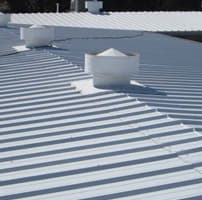Commercial low slope roofing: Water drainage and puncture resistance considerations
Commercial low slope roofing—defined as roofing which slopes four inches or less every foot—is common, as it provides the most space underneath the roof for offices, shops or manufacturing operations.
Special care must be taken, however, during material selection and installation for commercial low slope roofing systems, especially considering flatter slopes allow precipitation to roll more slowly off the surface of the roof. If a low slope roofing system is improperly installed or the wrong materials used, ponding water and leaks can become regular occurrences.
Your roofing contractor should be well-versed in different low slope roofing options for different commercial applications. If, for instance, you’d like to start a rooftop garden, then built up roofing might be the right option for your facility. However, if cost is the most important, then your roofing contractor might suggest a modified bitumen system to cut costs while still promoting durability and energy efficiency.
Here are several important considerations to keep in mind as you repair or install a commercial low slope roofing system:
- Planning ahead for proper water drainage
Leaks and ponding water—water that hasn’t drained 24 hours or more after precipitation—are major problems with low slope roofing. Or, at least, if it isn’t installed properly. Particular attention should be paid to valleys, flashings and the perimeter of the roofing system to prevent ice damming in the winter and ponding during warmer weather.A licensed roofing contractor such as Wildwood Roofing & Construction will be able to analyze your facility’s roof while taking into account your cost and climate constraints and guide you toward the right material choice to keep your roof dry and your facility leak free.

- Roofing systems designed with low slope applications in mind
By nature, commercial low slope roofing is exposed more directly to sun, rain and wind than steep roofing. Fortunately, roofing systems such as SPF roofing, PVC roofing and others are specifically designed for puncture resistance, UV reflection and weatherproofing.And, for systems such as built up roofs, protective coatings can be applied at the end of installation in order to reflect harmful UV radiation and provide further waterproofing and insulation. Materials such as shingles are not suited for low slope applications unless installed with extra underlayment to protect against wind-blown rain. Even then, there are single-ply membranes and hybrid roofing systems specifically designed for commercial low slope roofing applications.Your roofing contractor will be able to help you choose the right material for your facility’s unique needs.
Before beginning work on your low slope roof installation or repair, schedule a free consultation with Wildwood Roofing & Construction.
Here’s how it works. We’ll come to your facility—or, if you haven’t broken ground yet, talk to you about your design—and make recommendations based on years of experience with commercial low slope roofing systems in St. Louis. Then we’ll offer a quote for services, and we’ll stick to it. It’s that simple. No risks. No obligation. Just an open and honest conversation about your facility and its roofing needs.
Let’s chat about your facility’s needs.

